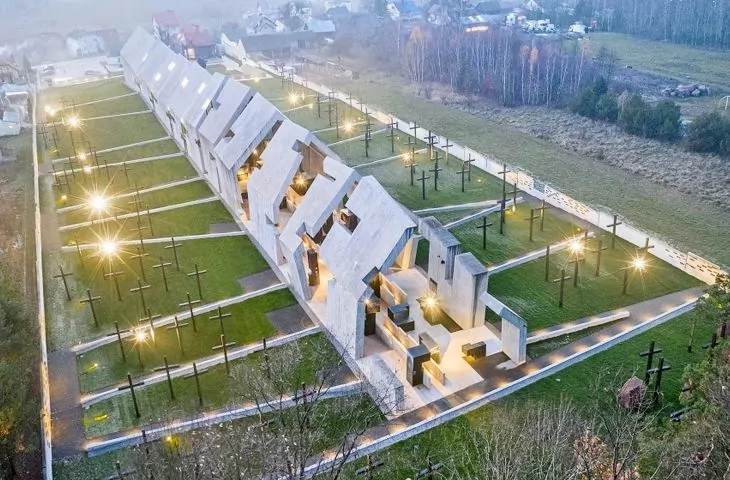July 12, 2021 marked the official opening ceremony of the memorial to the victims of the pacification of Michniów - the Mausoleum of Martyrdom of Polish Villages in Michniów. It has been almost 13 years since the project was designed by Nizio Design International studio. Its non-obvious form, a balanced combination of a museum and a monument, leaves the viewer with a great deal of unease and compels reflection.
On the 78th anniversary of the pacification of Michniów, the mass slaughter of the inhabitants of the Świętokrzyskie village by the German occupiers on July 12-13, 1943, the memorial to the victims of the massacre was officially opened.
We waited 13 years for the realization of the exceptionally original and - already - award-winning project of the Mausoleum of Martyrdom of Polish Villages in Mich niów. The project was created in 2009. At the time, the team led by Miroslaw Nizio won first prize in a competition announced by the investor - the Museum of the Kielce Village.
Looking at archival photos of the pre-war village of Michniów: cottages, inhabitants, scenes of daily life, we felt that we were communing with something full, complete, with a natural rhythm of life. On the other hand, looking through the photographs of the 1943 pacification, seeing human drama, death, burning huts, we touched the painful history, experienced the emotions accompanying the violent interruption of the lifeline. We felt this pervasive and growing destruction. This process was the impetus for the design of the block and the exhibition ," recalls Miroslaw Nizio.
Michniów on fire during the Nazi slaughter
© J. Fajkowski, "Village in Fire. The extermination of the Polish countryside during the Nazi occupation" (1972)
Destroyed village shortly after the aggression of the occupying forces
© J. Fajkowski, "Village in Fire. The extermination of a Polish village during the Nazi occupation" (1972)
A balanced combination of museum and monument
The form of the Mausoleum is highly unobvious. It completely stands apart from the monuments or memorials we know in Poland. It is an architectural combination of a museum and a monument. The authors of the project combined historical narrative with sculptural inspiration and architectural thinking about the building in a balanced way.
The mass reflects the process of destruction, which became the main inspiration for the project
photo: Marcin Czechowicz
The massing reflects the process of destruction, which became the main inspiration for the project. The mausoleum in the foreground resembles a country house. The first, complete part of the building is the House of Silence. Subsequent segments reflect the drama of the process that led to the disruption of a certain world order: the lump is degraded, destroyed, as after arson. In the structure of the concrete from which it is made, there are breakages, cuts, tears, which build up emotions and tension. The motif of disintegration arouses exceptional anxiety in the perception of the work. It is evident in the symbolic sequence of huts - each of them is damaged, fragmented, deserted - as if after a cataclysm or earthquake.
The main building block is concrete
Photo: Marcin Czechowicz
The mausoleum covers more than 16,000 sqm. The monolithic body is made up of as many as 11 segments. Entering the establishment, the visitor first reaches five closed segments. The sculptural, degraded part is open to nature, the sky and the landscape, changing - sometimes abruptly - as weather conditions change. Through the glazing and rips in the structure, the larch crosses surrounding the building are visible, whose shape and symbolism inspired the form of the rips. The expressive architecture and the deliberate, progressive degradation of the block creates a unique mood for the site. Through the cracks between the segments, light enters the building.
"Ripped" crosses
Photo: Marcin Czechowicz
The ascetic and cool perception of the structure is largely caused by the main building block - concrete, on which one can see the imprint of wood grains - a symbol of the passage of time and interference of natural forces in the color and texture of the material. The structure of the wall and roof, as well as the steel elements, bear traces of the action of water, dust, earthy dust. This makes the solid even more strongly united with its surroundings and takes root in the context of the place.
MMausoleum from a bird's eye view
photo: Marcin Czechowicz
coherence of architecture and exposition
The Nizio Design International team is responsible not only for the architectural layer of the project, but also for the permanent exhibition inside the Mausoleum. The consistency of these elements accounts for the high value of the project, which has been recognized more than once in architectural competitions and plebiscites in Poland and abroad.
Already in 2011, the studio received the European Property Award in the Public Service Architecture category for the Mausoleum project. Dezeen.com, one of the most influential portals on architecture and design, listed the Mausoleum in 2016 in a list of the 12 most anticipated architectural projects from around the world. In turn, in June 2021, Miroslaw Nizio received the Internauts' Award for the design of the memorial in Michniów in the 10th edition of the competition for the Architectural Award of the Polityka weekly.
Fragments of the permanent exhibition
photo: Marcin Czechowicz







































